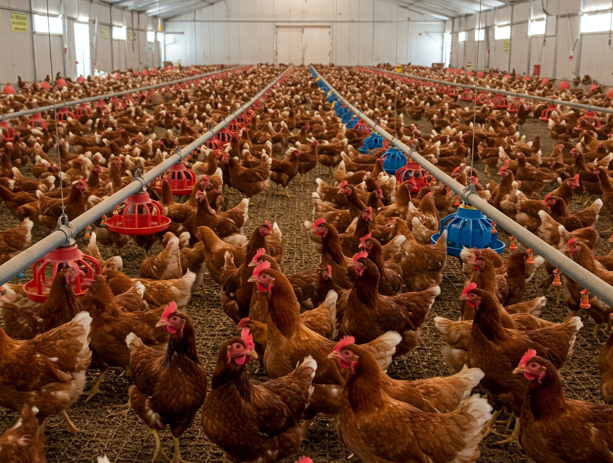
 Poultry farming /AI
Poultry farming /AIPoultry farming offers immense potential for food security and income generation, but that promise can quickly fade when disease strikes.
According to the Kenya Agricultural and Livestock Research Organisation (Kalro), maintaining flock health is not just important, it's central to the success of any poultry venture.
A single outbreak can wipe out dozens of birds, cut egg production, and severely dent profits.
Kalro advises that early detection begins with keen observation.
Healthy chickens are active, alert, and constantly moving.
They eat and drink regularly, their eyes are bright, their feathers are smooth, and they lay eggs consistently.
Their droppings are typically soft but compact. If a chicken appears drowsy, sluggish, or lies down more than usual, it could be a sign of illness.
Other warning signs include dull eyes, ruffled feathers, sneezing, wheezing, lack of appetite, and abnormal droppings, especially if they are bloody or watery.
Newcastle disease
Locally known as Kideri or Mdondo, Kalro notes that it spreads rapidly through contaminated food, water, or air, and often kills birds without warning. Infected chickens may display twisted necks, green diarrhoea, or paralysis of the wings or legs.
“There is no treatment for Newcastle disease. Vaccination is the only effective prevention,” says Kalro.
Chicks should be vaccinated at one week old, again at three weeks, and then regularly every few months to protect the flock.
Fowl Pox
Fowl pox is another disease that can significantly weaken birds.
It is transmitted through mosquito bites, skin wounds, or contaminated surfaces.
Affected chickens develop wart-like growths on their combs, wattles, and around the eyes, while yellow sores may form inside the mouth. Infected birds often lose weight and become weak.
“There’s no cure for fowl pox, but it can be managed through isolation, wound care, and vaccination,” Kalro says.
Vaccination is recommended between three and six weeks of age, and controlling mosquitoes around the coop can reduce the risk of infection.
Gumboro
Chicks aged three to six weeks are especially vulnerable to infectious bursal disease, also known as Gumboro.
This virus attacks the immune system, leaving young birds exposed to other infections. Symptoms include lethargy, white watery droppings, and swollen or dirty vents.
While there is no direct treatment, Kalro recommends supportive care such as multivitamins and antibiotics to prevent secondary infections.
Vaccination at 14 days old, followed by a booster a week later, offers the best protection.
Bacterial diseases
Bacterial infections also pose serious risks.
Pullorum disease primarily affects chicks between one and three weeks old and is often transmitted from infected hens through eggs.
Infected chicks may have swollen bellies, yellowish diarrhoea, and feces stuck to their vents.
Kalro recommends antibiotic treatment and advises farmers to remove hens that consistently produce sick chicks from the breeding programme.
Fowl typhoid, which mainly affects adult birds, is spread through contaminated feed, water, or contact with infected chickens.
Signs include green diarrhoea, swollen joints, fever, and a bluish comb, along with a sharp drop in egg production. Sick birds should be isolated, and the entire flock treated with antibiotics to stop further spread.
Chronic respiratory disease
Chronic respiratory disease is a condition that affects the lungs and throat, particularly in poor housing or stressful conditions.
It may also be inherited from the parent stock.
Symptoms include coughing, sneezing, noisy breathing, and slow growth.
“Mortality is usually low in good conditions, but productivity suffers,” says Kalro.
"Improving housing, ensuring proper nutrition, and seeking timely veterinary care are key to managing CRD. In severe outbreaks, culling and disinfecting housing may be necessary."
Parasites
Parasites such as mites, lice, and fleas live on the chicken’s skin and feathers, feeding on blood and causing discomfort.
Birds may shake their heads, scratch themselves, or lose feathers. Severe infestations can cause anaemia or death.
Cleanliness is essential. Kalro recommends regular disinfection of coops, quarantining new birds, and treating infestations with acaricides like Duduthrin or deltamethrin.
Internal parasites such as roundworms and tapeworms invade the digestive tract, leading to diarrhoea, weight loss, and stunted growth.
Severe infections can be fatal.
Kalro emphasises the importance of providing clean water, keeping feed off the ground, and deworming from eight weeks of age, repeating every three to six months while rotating drugs to prevent resistance.
Coccidiosis
Coccidiosis is a highly contagious parasitic disease that thrives in damp, dirty environments and spreads through droppings.
Birds may develop bloody or brown diarrhoea and become anaemic. If left untreated, it can kill young birds in days.
“The key to controlling coccidiosis is prevention—maintain hygiene, avoid overcrowding, and use anticoccidial drugs when necessary,” Kalro says.
Prevention
According to Kalro, the success of a poultry farm depends on vigilance and consistency.
Observing chickens daily, acting quickly at the first sign of trouble, and maintaining a healthy routine through vaccination, good housing, proper nutrition, and parasite control, are essential.
With proactive care and timely intervention, Kalro says farmers can protect their flocks, minimise losses, and build a thriving poultry business.
Would you like us to tell your story related to this topic? If yes, please send details to [email protected]












